I don't know the etymological meaning of Wawat. The etymology of kushite: ḫ_s, is determined by geography and ethnicity. The vowel associated with K_sh can be an /a/,/e/ or /u/. The root word is interpreted as a geographical term probably meaning hilly area.
The surrounding non Kush populations usually refered to the people living in these hilly areas as "blacks" or Nehesy. Thusly, Kush would mean "hilly land where the Nehesy [from the Sudan] live. I have not been able to determine what the etymology of Kush is based on the Kushite languages up to now.
The Kushites were originally called ḫЗšt ,Ta-Seti, Nehesy and Tehenu by the Egyptians The Kushites were called ḫ3s.t(j) beginning in Narmer’s time, and k3š in Middle Egyptian beginning with the 18th Dynasty.
The Kushites were called ḫЗst from Nubia and Taleh (Lower Egypt) into the Levant. Kushites had early settled in the Levant since Narmer times. We find Narmer's name on jars and serekhs from excavations in Israel and Palestine , for example Tel Erani, Arad, 'En Besor, Halif Terrace/Nahal Tillah and more(4). A bulla dating to this period makes it clear that this part of the Negev was called ḫЗts.t ("Kush") or ḫ3s.tj ("Kushite").
The Old Kingdom rulers also referred to the Kusites in Nubia as ḫ3st .
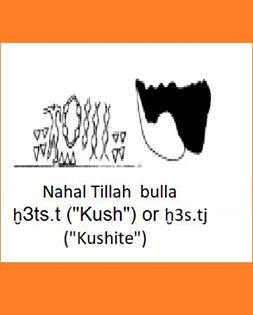
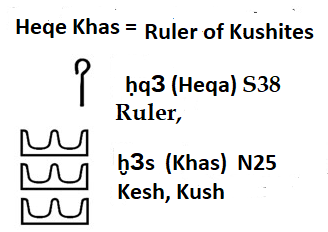
Most researchers accept the contemporary meaning of Gardiner's N25 symbol as "Rulers of foreign lands" not Kush”. But this was not the first meaning assigned this sign. Breasted translated N25, as "heqa ḫ3st ". In my book the Kushites, Who, What, When, Where, I explain that the Hyksos were Blacks native to Lower Egypt.
Semantically reading N25 as "Rulers of foreign land" is unintelligent, for example “Wawat Rulers of foreign lands” , is incorrect, because Wawat was the name of a nation, not a king. As a result, ḫ3st, was used to identify the nationality of the Wawat, Kau and other Kushite = ḫ3st.
Thusly, the inscription of Weni line 46 : “His majesty made war on the Asiatic Sand-dwellers and his majesty made an army of many ten thousands; in the entire South, southward to Elephantine, and northward to Aphroditopolis [Busiris]; in the Northland on both sides entire in the [stronghold], and in the midst of the [strongholds], among the Irthet "heqa ḫ3st [Kusites], the Mazoi "heqa ḫ3st [Kushites], the Yam "heqa ḫ3st [Kushites], among the Wawat "heqa ḫ3st [Kushites], among the Kau "heqa ḫ3st [Kushites], and in the land of Temeh.”
The Hyksos were also referred to as ḫ3st. The Hyksos ruled from 1650-1550.
The New Kingdom lasted from 1549-1292. During the New Kingdom Egyptians used the name Aamw, as a generic name for the Asian, the term : Habiru, was ethnonym for one of the Asian tribes. It is clear that if the Habiru and Heqa Khasut were the same people, they would have had the same name given the fact the New Kingdom, began at the end of the Heqa Khasut Dynasty.

There are many Hyksos inscription where they were identified as ḫ3st . The Hyksos door jamb signs reads “King of the Kushites. ḫ3st is also found on the Hyksos scarabs. These scarabs often begin with the title Heqa ḫ3st and the plural marker III, and should read “King of the Kushites”.
This is obvious when we look at the Khnumhotep II, inscription. Here we see above a Nubian ibis heqa ḫЗst, under the ibis is the name Abisharie. This inscription reads: "The Kushite King Abisharie".
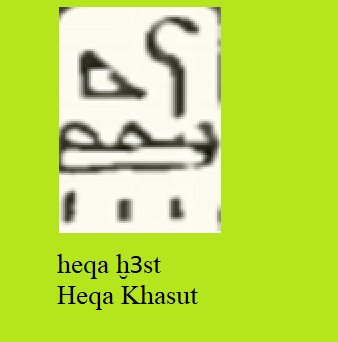
The Greeks called Kush: Ethiopia.
The earliest mention of the term k3š , is mentioned on the Buhen stela from the Sety1 (1294-1279). Kush was also written “KSH” in Egyptian text dating between 1550-1069 BC.
The native name of the Kingdom was recorded in Egyptian as k3š, based on the New Kingdom-era Akkadian transliteration as the genitive kūsi.
It is also an ethnic term for the native population who initiated the kingdom of Kush. The term is also displayed in the names of Kushite persons, such as King Kashta (a transcription of k3š-t3 "(one from) the land of Kush"). Geographically, Kush referred to the region south of the first cataract in general. Kush also was the home of the rulers of the 25th dynasty.
Some researchers believe Kush was derived from Qvs. Kush can not be derived from Qevs, there is no 'v', in Meroitic.
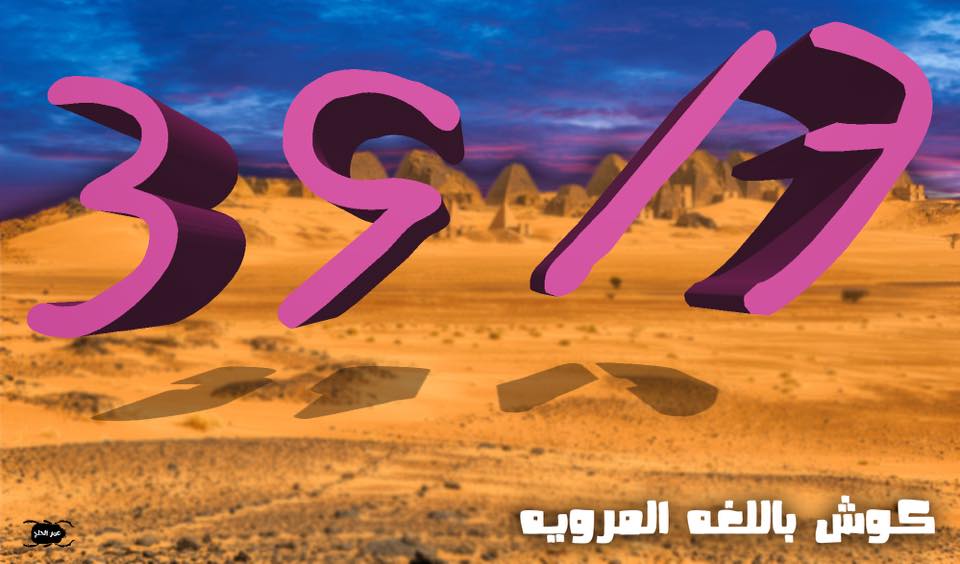
.
The Meroites called themselves Qus, but we may never know the exact meaning of Kush. L. Torok and J. Leclant have found In the Meroitic text that the Meroites referred to themselves as Qeš. I noted that in the Tanyidamani Stelas the Meroites called themselves Kushites/Qoshites. In the Tanyidamani inscription we read Qor ene Tañyidamani ne al e Qosne I bl p mni , “The Monarch, the Commander, the good and noble Tañyidamani, give [this] Kushite leave to praise and to supplicate Amani”.
The Handbook of Oriental Studies (New York:Brill,1997) out lines the history of the term Kush in relation to the Kushites on pages 2-3. Torok points out that the name for the first ruler of the Twenty-Fifth Dynasty, Kashta, probably meant "the Kushite" his nomen was k3š-t3 "of the land of Kush". He also noted that Kush, also appears as the ancestral kingdom of Piya in his Sandstone Stela and King Arqamani in the Second Century BC received the mortuary Horus name "The Kushite whose-coming-into-being -is divine".
The textual evidence make it obvious that the people of Meroe, and earlier rulers of Kerma and Napata from the same region, may have called themselves Kushites.

The people of Upper Nubia and the Sudan were known in Egyptian as k-'-s and k-'-s-I, as ḫЗts.t or Khasut which corresponds to Kashit and k3š-t3. The Hebrew people called the Kushites kus. In the cuneiform inscriptions the Sudanese were called Kusiya. In the Ethiopic inscriptions of Ezana, the Kushites were called Kashi or Kasu. In Sumerian the Kushites were called Melukha = Kasi and Kasi = Kush. The Meroites identified themselves as Qoš, Qes, Qos.
.
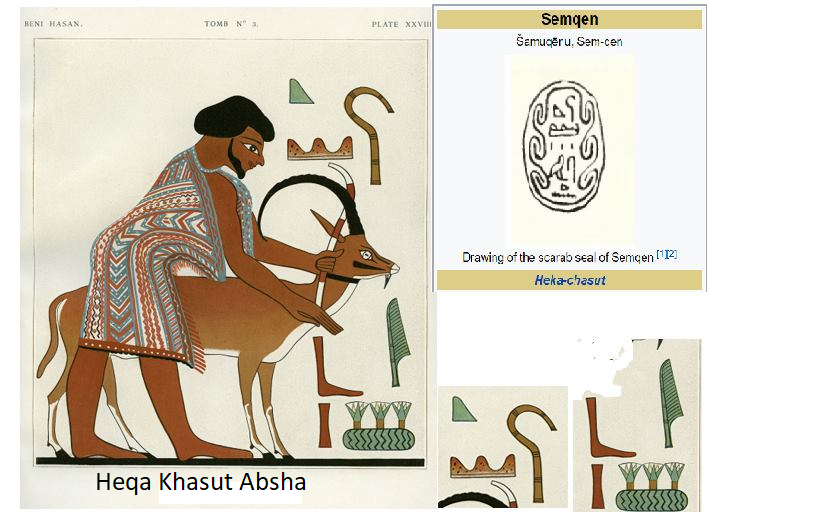
In conclusion, the presence ḫ3st in Line 46 of the Weni Inscription and the Narmer bulla indicates that since this area was called ḫЗts.t or Kush, since Narmer ruled the area he was a Kushite.
The k3š seems to have been used to refer to the Kushites during the New Kingdom.
The modern interpretation of Gardiner’s Egyptian sign N25 as ḫЗts.t is wrong. There is no evidence that /t/ should be added to ḫЗts.t, as a result I believe N25 was originally ḫЗs, not ḫЗst . Writing just Heqa ḫЗst means Kushite King, while adding three lines makes the plural: King of the Kushites.
Thusly on the Semqen scarab we have Semqen king of the Kushites. On the Khnumhotep II Beni Hassan inscription we have Heqa ḫЗst in front of the lead Hyksos above the Nubian ibis, and the name Abisharie below heqa ḫЗst.
.
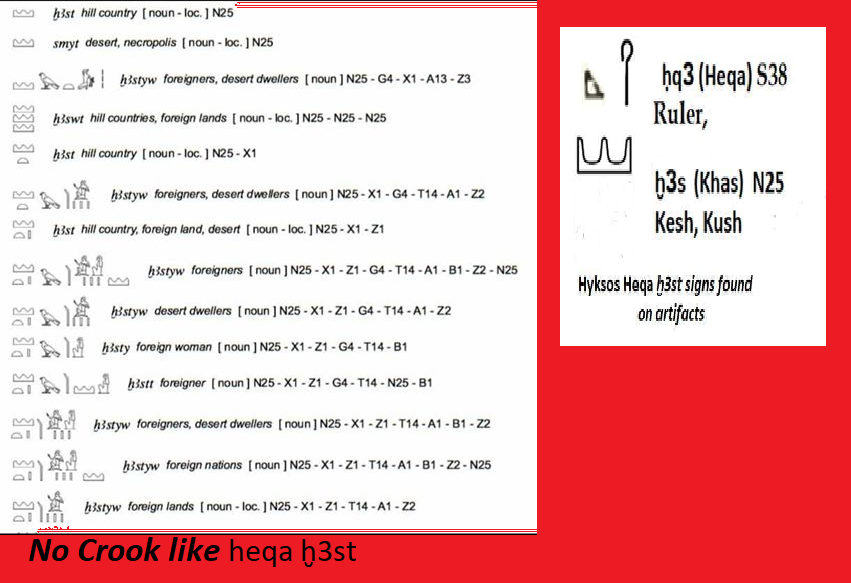





7 comments:
Sanks Dr.Clyde winter to tech our nation our civilization and who we are
"Кushla" - Other word for little outbuilding, straw, light structure temporary unstable
Is like small house for animals, round- with roof of straw.
You cant say sound [ ə ] ъ - it is bulgarian, roman, italian, indian, some other natons...
but most do not have - its close to more close mouth but not A or U or O or any sound..
This sound is when you want to say few letters togeder, wothoit sounds.. as KSHT - w can say them, without nothing.. not a not o or U - thats why we tipe [ ə ] ъ- sound, but mostly for writing because latinian phoneic do not have [ ə ] ъ - sound, we use letter "a" or "u" to replace the missing sound.
Tipe in google map -Kushta - and you will find some places
Tipe in google map Kushta - and you will see only placen in Bulgaria - a hundred...
Thats how I see in the map.
Bulgarian language is very old and it is not a Slavic, as they want... yes have some mixes, but we have super old words
I can explain a lot of egiptian gods, their names- we have words from them in the language for a many words.. but nobody talk abou this..
As they say if peoples go out from some areas around Etiopia, so maybe this antient tribe or peoples that build egipt, things are the same yours old antient gyisq but come from europe again back, and they start to build, because they already know the stones..
Peoples do no develop new tools- if they do not need them- and if they do not have enviroent
Thats why the first migrations, from Africa, where go more to europe, mountains asia - they start to develop new things- because the nature is different, the conditions
I hope to find my coment fo rinteresting
See Hindu Kush also
Kush and Kash are the same, also with O -- you can search a lot of words... with this soundings
because nobody can spell this [ə] ъ - sound, we in Kirilic script have letter for it.
But if in other languages do not have letters for this sound
- they will tipe in english with A or U
Look at this word - "Kuka" - in bulgarian means "a hook'
old word
to hook something - it's already hooked, therefore, a house means a place where you sat down, stayed or was attached/hooked to that place, or established in one place.
This is also the meaning of the words HOUSE as meaning.. not only place to hide, and live together, but place that you stay for long time!
Look at these Indian workshops - they are very old...some tribes
https://www.mesh.org.in/section876770.html
in their language they have both words - Kusht Seva Ashram (KUKA)
Kusht - means a House, Seva- means as "sew" Ashram- means temple, but the old meanings, before religon is like holy, spetial place to be in,
and (KUKA) - is short term - for House. which is a very old word for house.. in dialect
Arabs cant pronunce goo sound "u" - neither [ə] ъ
- thats why, the word is remembered and pronunced as KAshta
but is Kush, with [ə] ъ
Kuka -also means from bird - Kuku-rigu we call like this to one bird.. that make this sound
All houses super old times - as now yuo hve it - are round as nest, an on top have like tassel - something that sticks out
In old first belivs - of humans, chesk all africa also, you have a bird as top of the head,
thats why the House- is in this form, and have some Top - because to be with harmoni with the Soul, this is the soul of the house.. the Kuku=
Thts why all words are closer to eachother.... as meaning,
Thats why all the feathers that people put on - both in Africa and everywhere in the world - are on the head -
for the spirit is above the body in the head above it
The spirit is a bird - the personification of freedom, they are something above the things in the air in the sky.. for strength, etc.. according to it depends on the bird..
there are birds of strength - like eagle falcons, there are birds of peace, love, etc. - they are smaller
in bulgaria we call to a lovely girl, and kids- bird - "Pile" - so search also Pi - the word..
i think that the som of him Kashta son was Pi- roots name?
See how is simple - small birds make sound Pi-pi-Pi.. thats why we have wrod - Pi-le(small bird)
Even have conection with english word to give Birth , and Bird - almost the same.. but they deside to tipe it different.
and it is clear that men are personified with an oven as a rooster, because they preen like roosters and peacocks - to impress the female..
Кuk and hook - is the same - meaning
with the link from hooking someting and our word Kuka -
thats how nations make different language- just make some litthe changes...
Most important is to search the mening of the words.. not just some equal sounding, but what is the meaning.. and to see other tribes - what pronuntion has
For example all words with B- greeks tiped with V - and after that... our names and words - are changed in books and history... so some nations cant spell a lot of sounds..
We can spell evereting- in the world! hahah all kind of sounds.. no problem..
also we say Kok - for someting on top of the head -as hairstyle female or not, that you put together all hair as a nest.
something round - -Kok (so this word is also conected and have old meaning from bird, for soul, etc...)
I found all this things, for the birds, that reresent the soul and the god, in your African tribal legends.. from Yoruba tribe..
But ofcourse all over the Africa the simbols re the same for Sun, Bird, the Soul-god, etc..
Thats why all peoples around the world use the same simbols - because we are conected from one place... isn't we go out from Africa long time ago - few times.. look at DNA new reserches
sorry - im continuing -
Kashta
If you put -i as plural Kashti- you can find is Sanskrit what is mean...
Kastle - german word for a stone big house - yes?
I think that before long time ago, more than 50 000,some ships came all over the word, and they give to peoples the knowledges..
look this movie -
maybe there is answer- who knows?
Maybe we are older, than they told us... for evereting..
https://www.youtube.com/watch?v=a73lTcPAQfQ&list=PLA0yECHITs9luyTCax33pUTdR_ZSOZGYQ&index=21&t=1062s
the people from this really sunken continent (in the video link that I give in preview comment)- went to the other continents in boats - and so they scattered everywhere among the arcane tribes..
that's why we have common and same repeating stories about everything- but every power changes it according to their ideas.. they change things slightly - to control us
the recent religions, from the empires, which only use the slaves not only in Africa and in Europe and everywhere... are invented for power - they do not make a person free.
Post a Comment